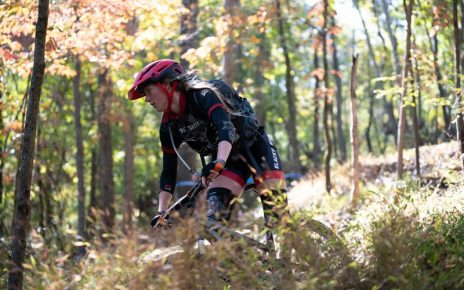Our complex bodies have evolved to work far harder than most modern occupations ask of them, so some of us pay for human hamster wheels to compensate. When the trails are too wet to ride without causing considerable damage, we head to the gym where we wait in lines to use machines that might maintain or improve our strength and fitness — if we can be convinced to return three or four times each week. What if we replaced one of those workouts with a hardy rake and shovel session in the forest?
Every rider knows that trail maintenance is the minimum tax for the joy of mountain biking on singletrack, and working on the trails that you love can also bring you bliss. Below are some of the ways that laboring on your local ribbons can benefit your physical and mental health, riding capabilities, and of course your greater community.
There are no queues or mirrors in the forest gym.
Whether you roll deep with all of your dedicated riding buddies or bring only a shovel to keep you company, heading into the forest with a few hand tools and a sandwich is a decidedly peaceful way to get a workout. Depending on the soil composition where you live, raking leaves out of the trail will help the dirt dry faster while making it easier for everyone to see the rocks and roots beneath the fallen foliage. You might even prevent someone from wasting petroleum with a cacophonous leaf blower, which is a sweet added benefit.
If you rake with some intention and upright posture, switching sides regularly, you can work most of the muscles in your upper body. Squatting to remove fallen branches, maintaining balance on slippery hillsides, pulling out invasive plants, and hiking will take care of the lower half. For folks in search of a deeper burn, ask your local trail association which corners or drainage lines need to be reshaped. If you have the feeling that a full day spent moving wet leaves and dirt is not enough of a workout, I implore you to give it a try. You will undoubtedly have some sore muscles the following day. Trail work may not replace your weekly max-rep-race-prep session, but it’s a splendid way to move your body outside.

While raking your way into shape you may uncover sections of trail that need further maintenance. You can report those concerns to your local trail crew if applicable, or gather a gaggle of friends and do the work yourselves. Check out IMBA’s trail building resources and courses to learn the best practices for trail maintenance and building. Most importantly, ask permission, and “think like water.”
As an aside, make sure to leave the track as natural as you found it. Maintenance doesn’t include removing obstacles that give a trail its technical character. If you want to move or remove a feature it’s always best to discuss it with other folks who regularly ride that trail.

You can find new lines on old tracks and close unwanted shortcuts.
There is no better way to learn a trail than to have surveyed and maintained every inch of it. You will find different ways to open a corner or see better grip options that weren’t apparent at speed. Even if you decide that the line you rode all summer is optimal, seeing the trail on foot will improve your experience of it. Once the soil dries up you will know every corner better than before, and might be able to ride deeper into “the zone.” Additionally, you might find intimidating features less so once you’ve canvased their surfaces from a few different angles.
While raking and removing debris, you will likely have some choices to make about things like shortcuts or “Strava-lines.” If your local Strava racers have straightened out all of the corners on your favorite trail, you can stack the leaves and debris in the middle of those shortcuts, and clean out the intended turns. In addition to maintaining the original character of the singletrack your efforts might help other riders see where the proper turns are. Some folks follow the Strava-lines simply because those are the ones that look the most ridden.
It often makes sense to rake and maintain the most popular trails first, and then move to those that receive the least sunshine, since they need all of the precious sun rays they can get. In the end, if you just work on your personal favorite track all winter it’s still helpful.

Sweating on the hillside connects you to the trails, the surrounding forest, and your community.
If certain singletracks bring substantial joy to your life, maintenance is a great way to return the love. The trail I shovel most often is also the one that I ride most frequently. It’s the descent portion of my lunch loop, and I love every last tricky off-camber root of it. Making time to clean and improve it throughout the winter gives all of those dry laps a unique value that wasn’t there before I moved some dirt myself.
As we have written in countless articles, being in the forest has a positive influence on your mental health in a number of ways. Trail maintenance offers a means to warmly enjoy the outdoors, to observe and learn about the plants and animals that live on and around your local singletrack. It’s an opportunity to take time and wonder while getting muddy like a kid, and to ingest all of the smells, sounds, and sights of the forest while you can’t ride through it. You might even have the sense that you are truly “checking in” with the same forest that you otherwise fly through as quickly as possible.
Finally, the most obvious and regularly touted benefit of trail maintenance is a communal one. You have the opportunity to do something that benefits everyone, and that feels great. Someone built the trails you have been riding on, and returning the favor by maintaining them and building new ones is a stellar way to thank the community of trail builders and users around you. You can even team up with friends who trail run, hike, or ride horses or motorcycles on your local singletrack to broaden the community and create the sort of connections that can help to expand your local network in the future.
Let’s dig in!


